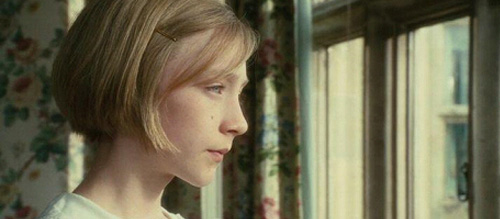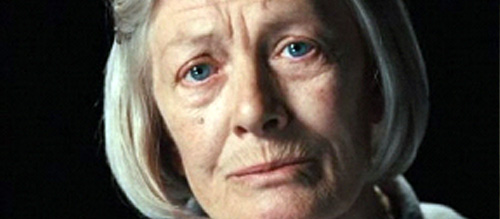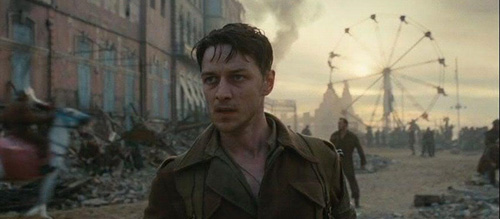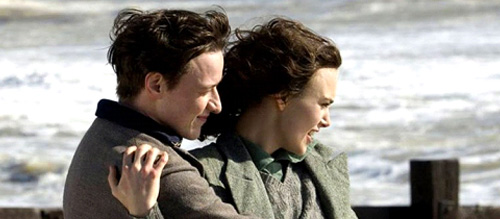What Novelists Are For: ‘Atonement’ at 15
Cold open. We’re looking at a dollhouse that resembles a grand country estate. The camera slowly pans out and away to reveal a flowery, wallpapered room with toys littering the floor. A young girl sits at her desk, clacking away at her typewriter. Her piercing blue eyes flutter across the page, her face serene with concentration. She snatches the final page from its grasp. The score – a lyrical melody accompanied by the rhythmic drum of typewriter keys – kicks in as the girl makes her way out of her room and through corridors. It builds to a triumphant climax.
Briony Tallis, thirteen years old, has just finished her first play.
Released in 2007 and directed by Joe Wright, Atonement is a film about stories: where they come from, why we tell them, and what happens when the line between reality and fantasy blurs. Adapted from Ian McEwan’s novel of the same, Atonement spans six decades, taking us from the English countryside to the evacuation of Dunkirk, to The Blitz, and back again. It is filmmaking on an epic scale, a true testament to the power of cinema. It remains just as affecting today, fifteen years after its release.
We begin in the summer of 1935. WWII is looming and it’s the hottest day of the year; a sense of uneasiness and restlessness permeates the air. Briony Tallis (Saoirse Ronan) enlists the help of her annoying cousins to perform in her play which she intends to put on for her whole family later that evening. But after Briony misinterprets a moment between her older sister, Cecilia (Keira Knightly), and Robbie (James MacAvoy), the housekeeper’s son, and her cousin Lola (Juno Temple) is attacked, Briony tells a lie that will alter the course of all their lives forever.

Adapting Atonement was surely a challenge given its nonlinear storytelling, but rather than simplifying the narrative director Joe Wright urged screenwriter Christopher Hampton to maintain the novel’s structure. Because of this, the film is separated into four distinct parts, each feeling like its own act, with Briony Tallis as the string that holds it all together. “I was kind of playing Briony as director,” Wright said during a behind-the-scenes featurette. “She’s written the film. She’s the eyes of the film.” Wright uses this perspective to call into question the very nature of storytelling itself, and he weaves this metanarrative seamlessly into the film’s visual language. Through Briony’s eyes, the summer of 1935 is hazy and overexposed – a perfect memory. The last good thing that ever happened. Her whole family is together and happy. New love is just beginning to bloom. We get the sense that this is not a factual retelling of events, but a reconstruction of them. Nothing is exactly as it happened – only how it’s remembered. Still, Atonement reminds us how we are often unreliable narrators, unable to see past our own recollections of events.
We relive key moments from several different perspectives, and these shifts in time are cut together so precisely and fluidly with clear visual clues for where we are in the timeline that it’s never confusing or frustrating. The score, composed by Dario Marianelli for which he won the Academy Award, shines during these sequences. The typewriter keys click in rhythm like a clock, turning back time.
While performances from Juno Temple and Benedict Cumberbatch are some of the film’s highlights, Atonement’s success and believability rests on the shoulders of the three actresses playing Briony at major turning points in her life. The hair and makeup departments went to great lengths to make Briony’s look consistent and recognizable throughout the film, and while it does seem silly that someone would keep the same exact hairstyle for decades, the result is striking. We believe they’re all Briony, with each performance representing different, complex, and often contradictory parts of her. Saoirse Ronan’s Briony is judgmental and bossy, too confident for her own good. She is both an innocent child and a willful liar, and Ronan manages to strike a perfect balance between the two. With Ramola Garai, Briony is a shell of her former self. She retreats inward, struggling to make sense of the mistakes she has made. Vanessa Redgrave is given the least amount of screen time as a much older Briony, but she makes the most of it. Her command of the camera is evident in her closing monologue, with nothing but herself and a black abyss to keep our attention.

One of the most stunning and talked about sequences in Atonement is the continuous, five-minute, Steadicam shot in which we follow Robbie (James McAvoy) and his two companions as they wander through the chaos and misery of the Evacuation of Dunkirk. With two days to rehearse, 1,000 extras to stage, and a million things that could go wrong, the resulting shot is a technical and artistic achievement, and its success owes a lot to the exhaustive work of Steadicam operator Peter Robertson. While the shot does indeed call attention to itself, that almost feels like the point. There’s no cutting, no opportunity to look away. Robbie cannot escape this nightmare and all we can do is watch. We’re forced to sit with the uncomfortable truths of war, all honor and glory stripped away.

The ending of Atonement is a gut punch. When Briony works up the nerve to face Cecilia and Robbie, finally taking responsibility for her lies all those years ago, he asks her to do one thing: write it all down. “No rhymes. No embellishments,” he says. But in the final moments of the film, when Briony speaks directly to us, we learn that she could not keep this promise. The story we just saw wasn’t the truth, it wasn’t what really happened. She made it up. It was a fantasy, an atonement for all the suffering she caused. The happily ever after we so longed for is snatched away from us, replaced by cold, hard reality. “But what sense of hope could a reader derive from an ending like that?” Briony wonders aloud. And indeed Briony’s confession is not the true ending of Atonement. The final images of the film are that of Robbie and Cecilia walking along the beach near their cottage, happy and alive. Briony gives them the chance to live and love, forever sealed within the pages of her novel. Her words will live on long after she has gone. Stories are, after all, an act of remembering.

Written by Margaret Roarty
You can support Margaret Roarty at the following links:
Twitter – @ManicMezzo
Podcast Instagram – @justmythoughtsonitpod
Podcast Twitter – @thoughtsonitpod
Listen to Just My Thoughts on It – Anchor

